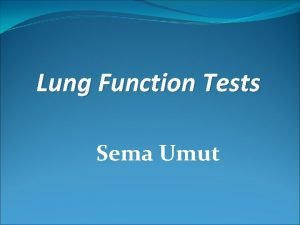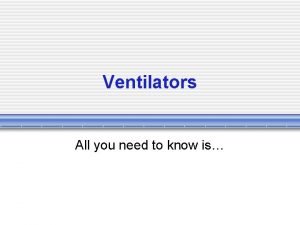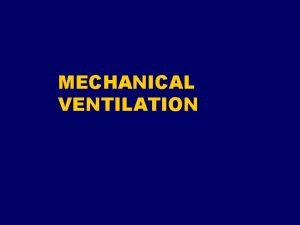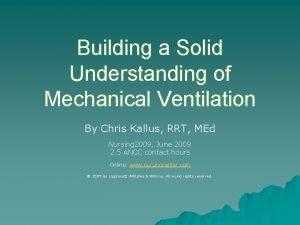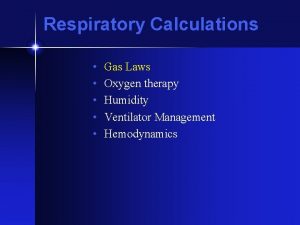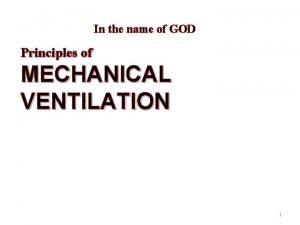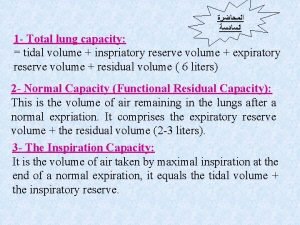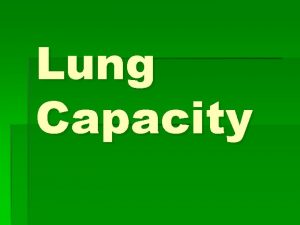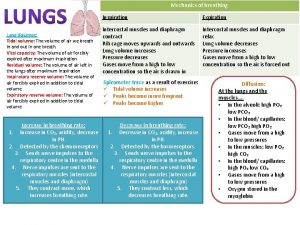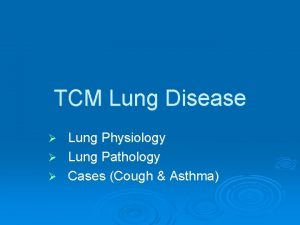Types of lung volume or capacity Tidal volume








- Slides: 8

Types of lung, volume or capacity Tidal volume – the amount of air which you breathe in and out, normally. It increases with exercise. Inspiratory capacity – the amount of air takes in after a normal expiration when forced breathing is taking place. It increases with exercise. Expiratory reserve volume – the amount of air which can be forced out after a normal expiration. There is a slight decrease in this during exercise. Vital capacity – the largest volume of air which can be expired after the deepest possible inspiration. There is a slight decrease during exercise. Residual volume – the amount of air which remains in the lungs after maximum expiration. There is a slight increase in this during exercise.

Types of lung, volume or capacity (cont. ) The total lung capacity is worked out by adding the vital capacity to the residual volume. It is possible to measure the lung capacities but this is not always a good indicator of either fitness/levels of endurance, although the greater your capacity, the more likely you are to be successful at endurance events. It will show up abnormalities which could be caused by asthma or excessive smoking but it is the efficiency of the respiratory system that is most important.

Types of lung, volume or capacity (cont. ) Inhaled air and exhaled air are completely different. Inhaled air is high in oxygen and nitrogen but low in carbon dioxide. Exhaled air is high in nitrogen and oxygen but has much higher levels of carbon dioxide. It is a misconception (wrong) that we simply breathe in oxygen and breathe out carbon dioxide, as neither of these make up the highest proportion of the air we breathe. Breathe in Breathe out Nitrogen – 79% Nitrogen - 79% Oxygen - 21% Oxygen – 16% Carbon dioxide – 0. 004% Carbon dioxide – 4% The exchange of these two gases occurs in the lungs.

Interesting Fact In the respiratory process, it is wrongly assumed that air is inhaled in and only carbon dioxide is exhaled out. In fact, explain first aiders give mouth to mouth resuscitation to someone who stops breathing because there is still enough oxygen in the air breathed out.

Gaseous exchange This is the process which allows oxygen to be taken in from the air and for it to be “exchanged” for carbon dioxide. This is how it happens: Oxygen, which has been breathed in, passes through the alveoli air sacs and into the red blood cells. The oxygen combines with the haemoglobin to form oxyhaemoglobin. An enzyme in the red cells breaks down the carbon dioxide, which is being transported in the blood (in the form of sodium bicarbonate) and turns it into a gas. The carbon dioxide gas then passes back through the alveoli and is breathed out through the lungs.

Gaseous exchange (cont). The gaseous exchange process is vital for our bodies because it is the combination of food and oxygen acting together which produces the body’s energy. The carbon dioxide and water are the waste products which must be removed.

Exercise and the respiratory system An increase in the activity of the body, such as vigorous exercise, will have the following effects: Breathing rate – this will increase greatly, up to three times the resting rate. The breathing becomes noisier and more obvious. VO 2 (or oxygen uptake) – this will increase greatly. The body will need more oxygen as energy so the uptake will have to increase to cater for this. Quite simply, the more exercise you do, the more oxygen you need, but this can only go up to certain levels, so when you are at your limit you have achieved V 02 maximum.

Exercise and the respiratory system (cont. ) Oxygen debt - if you work very hard during a physical activity you may find that you are out of breath for quite a time after you have finished. This is because your body has needed more oxygen than you were able to supply and you have experienced oxygen debt. Your body had managed to keep working by using the lactic acid system where glucose is broken down in the muscle system. Too much lactic can lead to fatigue and tiredness and even stiffness in the muscles after exercise. Vital capacity – (the largest volume of air which can be expired after the deepest possible inspiration). This will increase, as the volume of air required has increased. Residual volume – (the amount of air which remains in the lungs after maximum expiration). This only increases slightly. Tidal volume – (the amount of air which you breathe in and out, normally). This also increases slightly.

